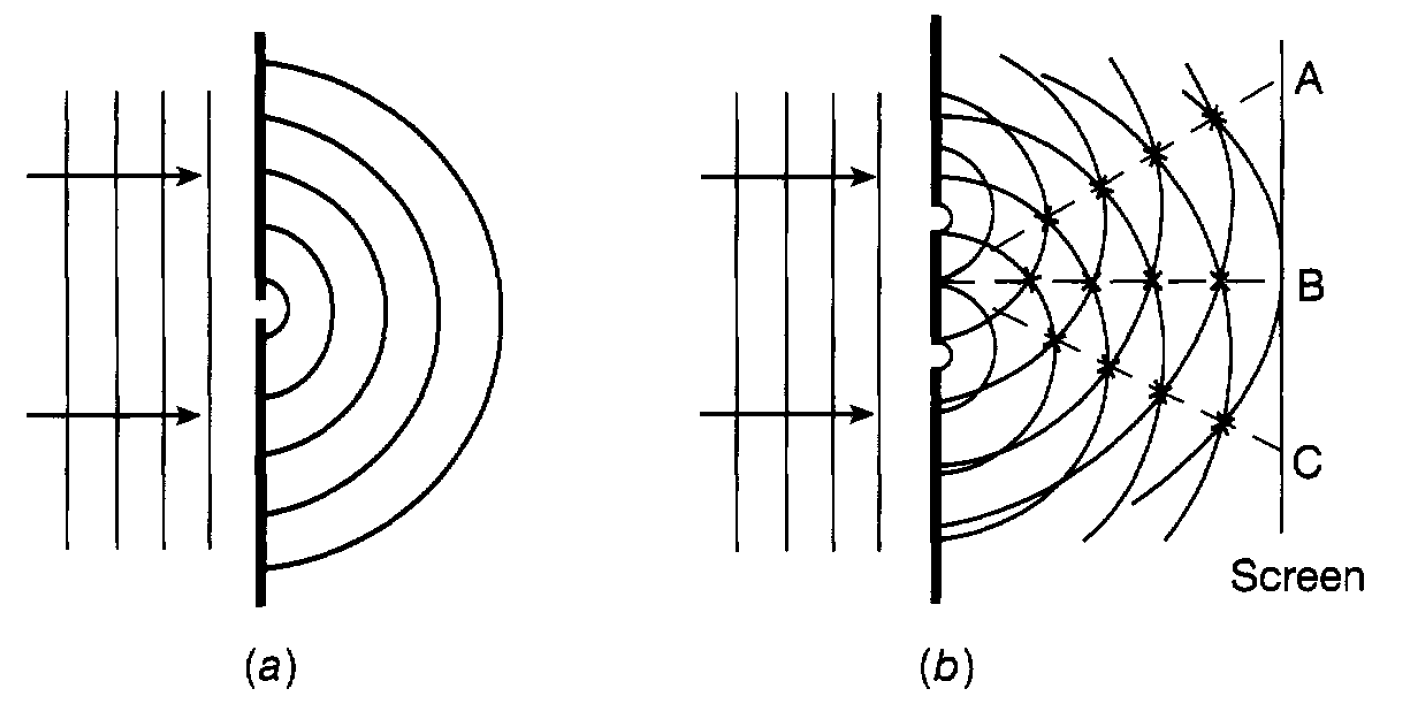


 الفيزياء الكلاسيكية
الفيزياء الكلاسيكية
 الكهربائية والمغناطيسية
الكهربائية والمغناطيسية
 علم البصريات
علم البصريات
 الفيزياء الحديثة
الفيزياء الحديثة
 النظرية النسبية
النظرية النسبية
 الفيزياء النووية
الفيزياء النووية
 فيزياء الحالة الصلبة
فيزياء الحالة الصلبة
 الليزر
الليزر
 علم الفلك
علم الفلك
 المجموعة الشمسية
المجموعة الشمسية
 الطاقة البديلة
الطاقة البديلة
 الفيزياء والعلوم الأخرى
الفيزياء والعلوم الأخرى
 مواضيع عامة في الفيزياء
مواضيع عامة في الفيزياء|
Read More
Date: 22-5-2016
Date: 7-3-2016
Date: 7-3-2016
|
The Interference and Diffraction of light
Was mentioned that interference can take place between waves and this is a phenomenon which is well studied in the context of light waves. Consider a light wave striking an impenetrable screen with a very narrow (much smaller than the wavelength of the light) slit in it as shown in figure 1.1(a) where the vertical lines again represent peaks in the wave amplitude. Light to the right of the screen clearly originates only from the slit and this leads to circular wave fronts moving out as shown. The light, instead of simply moving forwards. spreads out in all directions and the process is referred to as diffraction. This is a phenomenon which can be similarly observed when waves on the surface of water strike a barrier with a small gap in it. Consider now the situation which arises when there are two such slits as in figure 1.1(b). Clearly the wave fronts from the two slits will interfere with each other and the crosses indicate points at which crests of each circular wave coincide. They enhance each other and lead to what is called constructive interference. Similarly. where crest and trough coincide, there is cancellation and destructive interference takes place. If the light passing through the

Figure 1.1: (a) Circular wave fronts from a narrow slit; (b) interference from two slits.
two slits is allowed to fall onto a screen as shown then there will be bright areas at A, B and C and dark areas in between where destructive interference is taking place. More detailed considerations show that B is the brightest area and that the intensity of the light in the other bright areas decreases the further they are away from B. The pattern of light and dark areas on the screen is known as an interference pattern. Return now to the light emanating from a single slit, but consider the situation where the slit is wider with a width of the same order of magnitude as the wavelength of the incident light. Whereas with a very narrow slit the circular wave is generated from effectively one position, now there are many positions available within the slit and so many circular waves are generated from each point in the slit. These waves, like those from the two slits in figure 1.1(b) will clearly interfere with each other and if the light from this wider slit falls onto a screen a pattern of light and dark areas is obtained; this is known as a diffraction pattern. Similar to the two slit interference pattern, the central area is the brightest and is surrounded by alternating dark and much less intense brighter areas. Clearly the separation between these areas is characteristic of the wavelength of the light falling on the slit and a measurement of this separation can, in principle, be used to measure the wavelength of the light. With a single slit the bright and dark areas on the screen are very broad and fuzzy and it is impossible to make a precise measurement, but if there are many slits, as in what is referred to as a diffraction grating, the interference effects are such as to produce very narrow bright lines which enable immensely precise measurements of wavelength to be made. Diffraction gratings are made, for example, by ruling many parallel lines with a diamond point on a glass surface.



|
|
|
|
إجراء أول اختبار لدواء "ثوري" يتصدى لعدة أنواع من السرطان
|
|
|
|
|
|
|
دراسة تكشف "سببا غريبا" يعيق نمو الطيور
|
|
|
|
|
|
لأعضاء مدوّنة الكفيل السيد الصافي يؤكّد على تفعيل القصة والرواية المجسّدة للمبادئ الإسلامية والموجدة لحلول المشاكل المجتمعية
|
|
|
|
قسم الشؤون الفكرية يناقش سبل تعزيز التعاون المشترك مع المؤسّسات الأكاديمية في نيجيريا
|
|
|
|
ضمن برنامج عُرفاء المنصّة قسم التطوير يقيم ورشة في (فنّ الٕالقاء) لمنتسبي العتبة العباسية
|
|
|
|
وفد نيجيري يُشيد بمشروع المجمع العلمي لحفظ القرآن الكريم
|